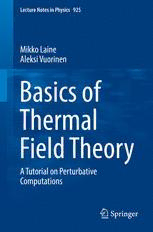
Basics of Thermal Field Theory: A Tutorial on Perturbative Computations PDF
Preview Basics of Thermal Field Theory: A Tutorial on Perturbative Computations
Lecture Notes in Physics 925 Mikko Laine Aleksi Vuorinen Basics of Thermal Field Theory A Tutorial on Perturbative Computations Lecture Notes in Physics Volume 925 FoundingEditors W.Beiglböck J.Ehlers K.Hepp H.Weidenmüller EditorialBoard M.Bartelmann,Heidelberg,Germany B.-G.Englert,Singapore,Singapore P.HaRnggi,Augsburg,Germany M.Hjorth-Jensen,Oslo,Norway R.A.L.Jones,Sheffield,UK M.Lewenstein,Barcelona,Spain H.vonLoRhneysen,Karlsruhe,Germany J.-M.Raimond,Paris,France A.Rubio,Donostia,SanSebastian,Spain M.Salmhofer,Heidelberg,Germany S.Theisen,Potsdam,Germany D.Vollhardt,Augsburg,Germany J.D.Wells,AnnArbor,USA G.P.Zank,Huntsville,USA The Lecture Notes in Physics The series Lecture Notes in Physics (LNP), founded in 1969, reports new devel- opmentsin physicsresearch and teaching-quicklyand informally,but with a high qualityand the explicitaim to summarizeand communicatecurrentknowledgein anaccessibleway.Bookspublishedinthisseriesareconceivedasbridgingmaterial between advanced graduate textbooks and the forefront of research and to serve threepurposes: (cid:129) to be a compact and modern up-to-date source of reference on a well-defined topic (cid:129) to serve as an accessible introduction to the field to postgraduate students and nonspecialistresearchersfromrelatedareas (cid:129) to be a source of advanced teaching material for specialized seminars, courses andschools Bothmonographsandmulti-authorvolumeswillbeconsideredforpublication. Editedvolumesshould,however,consistofaverylimitednumberofcontributions only.ProceedingswillnotbeconsideredforLNP. VolumespublishedinLNParedisseminatedbothinprintandinelectronicfor- mats,theelectronicarchivebeingavailableatspringerlink.com.Theseriescontent isindexed,abstractedandreferencedbymanyabstractingandinformationservices, bibliographicnetworks,subscriptionagencies,librarynetworks,andconsortia. Proposalsshouldbe sent to a memberof the EditorialBoard, ordirectly to the managingeditoratSpringer: ChristianCaron SpringerHeidelberg PhysicsEditorialDepartmentI Tiergartenstrasse17 69121Heidelberg/Germany [email protected] Moreinformationaboutthisseriesathttp://www.springer.com/series/5304 Mikko Laine (cid:129) Aleksi Vuorinen Basics of Thermal Field Theory A Tutorial on Perturbative Computations 123 MikkoLaine AleksiVuorinen AEC,InstituteforTheoreticalPhysics DepartmentofPhysics UniversityofBern UniversityofHelsinki Bern,Switzerland Helsinki,Finland ISSN0075-8450 ISSN1616-6361 (electronic) LectureNotesinPhysics ISBN978-3-319-31932-2 ISBN978-3-319-31933-9 (eBook) DOI10.1007/978-3-319-31933-9 LibraryofCongressControlNumber:2016941737 ©SpringerInternationalPublishingSwitzerland2016 Thisworkissubjecttocopyright.AllrightsarereservedbythePublisher,whetherthewholeorpartof thematerialisconcerned,specificallytherightsoftranslation,reprinting,reuseofillustrations,recitation, broadcasting,reproductiononmicrofilmsorinanyotherphysicalway,andtransmissionorinformation storageandretrieval,electronicadaptation,computersoftware,orbysimilarordissimilarmethodology nowknownorhereafterdeveloped. Theuseofgeneraldescriptivenames,registerednames,trademarks,servicemarks,etc.inthispublication doesnotimply,evenintheabsenceofaspecificstatement,thatsuchnamesareexemptfromtherelevant protectivelawsandregulationsandthereforefreeforgeneraluse. Thepublisher,theauthorsandtheeditorsaresafetoassumethattheadviceandinformationinthisbook arebelievedtobetrueandaccurateatthedateofpublication.Neitherthepublishernortheauthorsor theeditorsgiveawarranty,expressorimplied,withrespecttothematerialcontainedhereinorforany errorsoromissionsthatmayhavebeenmade. Printedonacid-freepaper ThisSpringerimprintispublishedbySpringerNature TheregisteredcompanyisSpringerInternationalPublishingAGSwitzerland Preface These notes are based on lectures delivered at the Universities of Bielefeld and Helsinki, between 2004 and 2015, as well as at a number of summer and winter schools, between 1996 and 2015. The early sections were strongly influenced by lectures by Keijo Kajantie at the University of Helsinki, in the early 1990s. Obviously,thelecturesadditionallyoweanenormousgratitudetoexistingtextbooks andliterature,particularlytheclassicmonographbyJosephKapusta. There are several good textbooks on finite-temperature field theory, and no attemptis made here to join that group.Rather, the goalis to offeran elementary expositionofthebasicsof perturbativethermalfield theory,in an explicit“hands- on”stylewhichcanhopefullymoreorlessdirectlybetransportedtotheclassroom. Thepresentationismeanttobeself-containedanddisplayalsointermediatesteps. The idea is, roughly,thateach numberedsection couldconstitute a single lecture. Referencingissparse;onmoreadvancedtopics,aswellasonhistoricallyaccurate references, the reader is advised to consult the textbooks and review articles in Refs.[1–12]. These notes could not have been put together without the helpful influence of many people, varying from students with persistent requests for clarification; colleagues who have used parts of an early version of these notes in their own lecturesandsharedtheirexperienceswithus;colleagueswhoseinterestinspecific topics has inspired us to add corresponding material to these notes; alert readers whohaveinformedusabouttypographicerrorsandsuggestedimprovements;and collaboratorsfromwhomwehavelearnedpartsofthematerialpresentedhere.Let us gratefullyacknowledgein particular Gert Aarts, Chris Korthals Altes, Dietrich Bödeker, Yannis Burnier, Stefano Capitani, Simon Caron-Huot, Jacopo Ghiglieri, Ioan Ghisoiu, Keijo Kajantie, Aleksi Kurkela, Harvey Meyer, Guy Moore, Paul Romatschke, Kari Rummukainen, York Schröder, Mikhail Shaposhnikov,Markus Thoma,andMikkoVepsäläinen. Bern,Switzerland MikkoLaine Helsinki,Finland AleksiVuorinen January2016 v Notation Inthermalfieldtheory,bothEuclideanandMinkowskianspacetimesplayarole. IntheEuclideancase,wewrite Z X (cid:2).(cid:2);xi/; x(cid:2)jxj; S D L ; (1) E E X whereiD1;:::;d, Z Z Z Z Z ˇ 1 (cid:2) d(cid:2) ; (cid:2) ddx; ˇ (cid:2) ; (2) X 0 x x T andd is the space dimensionality.Fourieranalysisis carriedoutin the Matsubara formalismvia Z P K (cid:2).k ;k/; k(cid:2)jkj; (cid:3).X/D (cid:3)Q.K/eiK(cid:2)X ; (3) n i K where Z Z Z Z P X ddk (cid:2)T ; (cid:2) : (4) .2(cid:4)/d K kn k k Here,knstandsfordiscreteMatsubarafrequencies,whichattimesarealsodePnoted by ! . In the case of antiperiodicfunctions, the summation is written as T . n fkng Thesquaresoffour-vectorsreadK2 Dk2Ck2andX2 D(cid:2)2Cx2,buttheEuclidean n scalarproductbetweenK andXisdefinedas Xd K(cid:3)X Dk (cid:2) C kxi Dk (cid:2) (cid:4)k(cid:3)x; (5) n i n iD1 vii viii Notation wherethe vectornotationis reservedforcontravariantMinkowskianvectors:x D .xi/,kD.ki/.Ifachemicalpotentialisalsopresent,wedenotekQ (cid:2)k Ci(cid:5). n n IntheMinkowskiancase,wehave Z X (cid:2).t;x/; x(cid:2)jxj; S D L ; (6) M M X R R R where (cid:2) dx0 .Fourieranalysisproceedsvia X x Z K(cid:2).k0;k/; k(cid:2)jkj; (cid:3).X/D (cid:3)Q.K/eiK(cid:2)X ; (7) K R R R where D dk0 ,andthemetricischosentobeofthe“mostlyminus”form, K 2(cid:4) k K(cid:3)X Dk0x0(cid:4)k(cid:3)x: (8) No special notation is introduced for the case where a Minkowskian four-vector is on-shell, i.e., when K D .E ;k/; this is to be understood from the context. k The argument of a field (cid:3) is taken to indicate whether the configuration space is EuclideanorMinkowskian.Ifnotspecifiedotherwise,momentumintegrationsare regulatedby definingthe spatial measure in d D 3(cid:4)2(cid:6) dimensions,whereasthe spacetimedimensionalityisdenotedbyDD4(cid:4)2(cid:6).AGreekindextakesvaluesin thesetf0;:::;dgandaLatinoneinf1;:::;dg. Finally,wenotethatweworkconsistentlyinunitswherethespeedoflightcand theBoltzmannconstantk havebeensettounity.ThereducedPlanckconstant„also B equalsunityinmostplaces,excludingthefirstchapter(onquantummechanics)as wellassomelaterdiscussionswherewewanttoemphasizethedistinctionbetween quantumandclassicaldescriptions. General Outline Physics Context From the physics point of view, there are two important contexts in which rela- tivisticthermalfieldtheoryisbeingwidelyapplied:cosmologyandthetheoretical descriptionofheavyioncollisionexperiments. In cosmology, the temperatures considered vary hugely, ranging from T ' 1015GeV to T ' 10(cid:3)3eV. Contemporarychallenges in the field include figuring outexplanationsfortheexistenceofdarkmatter,theobservedantisymmetryinthe amountsofmatterandantimatter,andtheformationoflarge-scalestructuresfrom smallinitialdensityperturbations.(Theoriginofinitialdensityperturbationsitself isgenerallyconsideredtobeanonthermalproblem,associatedwithanearlyperiod of inflation.) An importantfurther issue is that of equilibration,i.e., details of the processesthroughwhichtheinflationarystate turnedintoathermalplasmaandin particularwhatthehighesttemperaturereachedduringthisepochwas.Itisnotable thatmostofthesetopicsareassumedtobeassociatedwithweakorevensuperweak interactions, whereas strong interactions (QCD) only play a background role. A notableexceptiontothisislightelementnucleosynthesis,butthiswell-studiedtopic isnotinthecenterofourcurrentfocus. In heavy ion collisions, in contrast, strong interactions do play a major role. The lifetime of the thermal fireball created in such a collision is (cid:5) 10fm/c, and the maximal temperature reached is in the range of a few hundred MeV. Weak interactionsaretooslowtotakeplacewithinthelifetimeofthesystem.Prominent observablesare the yields of differentparticle species, the quenchingof energetic jets, and the hydrodynamicpropertiesof the plasmathatcan be deducedfromthe observedparticle yields. An importantissue is again how fast an initial quantum- mechanicalstateturnsintoanessentiallyincoherentthermalplasma. Despitemanydifferencesinthephysicsquestionsposedandinthemicroscopic forces underlying cosmology and heavy ion collision phenomena, there are also similarities. Most importantly, gauge interactions (whether weak or strong) are essential in both contexts.Because of asymptotic freedom,the strong interactions ix
